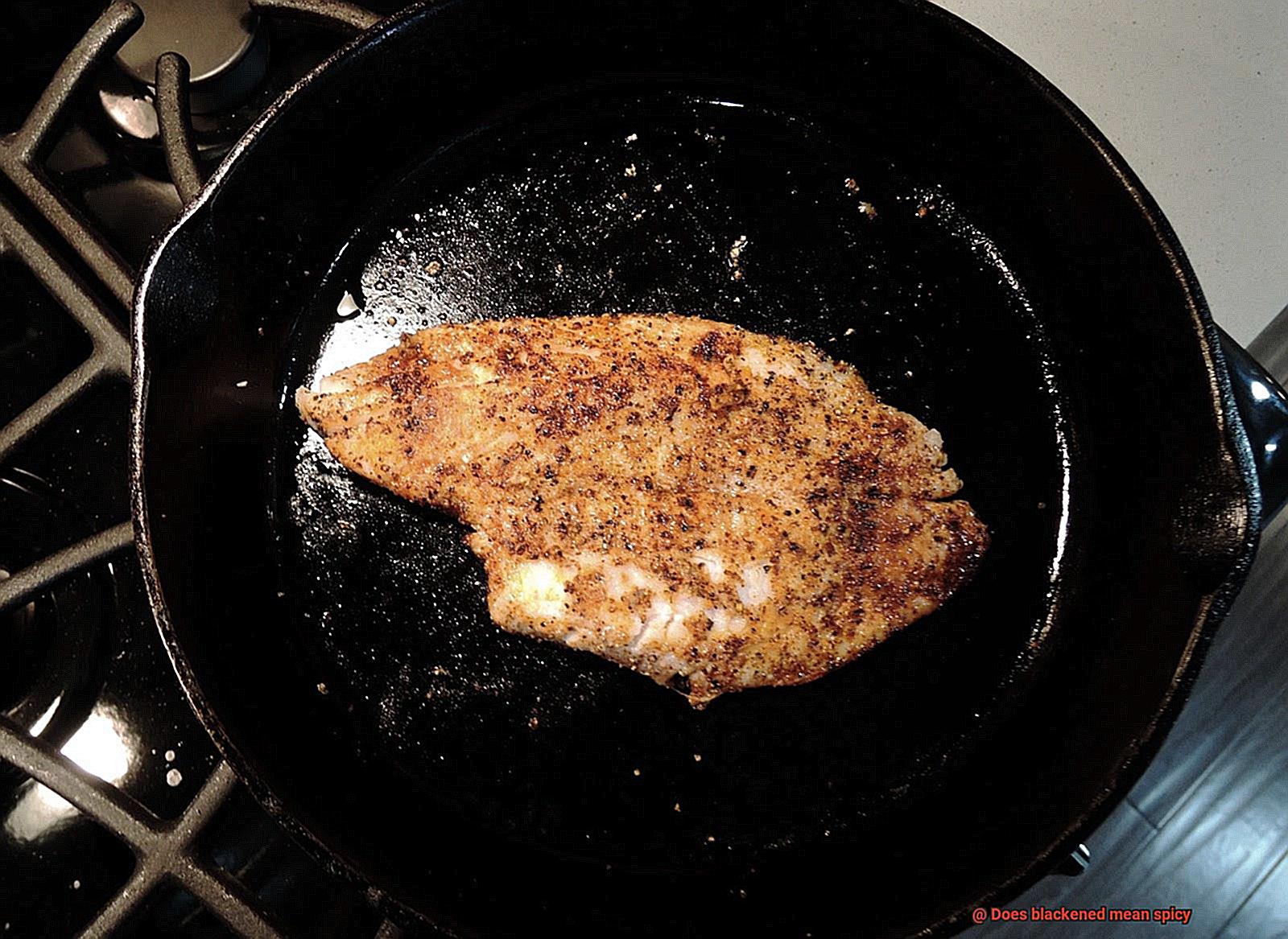Have you ever taken a bite of a dish labeled “blackened” and felt like your mouth was on fire? Many people assume that “blackened” means spicy, but as an expert in culinary terminology, I can tell you that this is not always the case. In fact, the term “blackened” refers to a cooking technique that originated in Cajun cuisine.
To achieve the blackening effect, chefs coat a protein such as fish or chicken with a blend of spices and sear it in a cast-iron skillet until a charred crust forms. While some blackening spice blends can be quite spicy, others are milder and feature seasonings like garlic, paprika, and onion powder.
So how do you know if your blackened dish will be spicy or not? The answer lies in the recipe and the cook’s preference. Some chefs may opt for hotter seasonings like cayenne pepper and chili powder while others may use milder spices.
In this blog post, we’ll explore the nuances of blackening technique and take a closer look at some popular dishes that utilize this method. We’ll also delve into key spices used in blackened dishes and how they impact flavor profiles. So get ready to expand your culinary knowledge and never make assumptions about “blackened” again.
Contents [show]
Origins of Blackening Technique
If you’re a food enthusiast, you know that the blackening technique creates a smoky and flavorful crust on meat or fish by searing it at high temperatures. However, not many know that it originated with Chef Paul Prudhomme in Louisiana in the 1980s. Through his restaurant, K-Paul’s Louisiana Kitchen in New Orleans, Chef Prudhomme introduced the world to the bold flavors and charred crusts of blackened dishes.
Prudhomme wanted to infuse bold flavors into mild-tasting fish like redfish or catfish. He developed a spice blend that included paprika, cayenne pepper, garlic powder, and thyme. He then coated the fish with these spices and cooked it in a hot cast-iron skillet until it formed a dark crust on the surface. This technique became known as blackening.
Chef Prudhomme’s blackened redfish quickly became famous and almost led to overfishing in the Gulf of Mexico. However, it wasn’t just the spiciness of the dish that made it popular. The cooking method used to create the smoky and flavorful crust was just as important.
While many associate blackened dishes with Cajun cuisine and spiciness, not all blackened dishes are necessarily spicy. In fact, traditional seasoning blends like Tony Chachere’s Original Creole Seasoning do not contain heat-inducing spices like cayenne pepper or chili powder. Instead, they rely on a combination of herbs and spices like paprika, garlic powder, onion powder, and thyme to enhance the natural flavors of meat or fish.
It’s essential to note that blackening is more about the cooking technique and the darkened crust than it is about the spiciness of the dish. The level of heat can be adjusted by varying the amount of cayenne pepper used in the spice blend. Therefore, it’s important to read the ingredients list of any pre-made seasoning blends and adjust the amount of spice used based on personal preference.
Commonly Used Dishes with Blackening Technique
Look no further than the blackening technique, a cooking method that creates bold flavors and crispy crusts. As an expert in all things blackened, I’m here to share some of the most commonly prepared dishes using this technique.

First on the list is the classic blackened fish dish. Redfish and catfish are the most popular options, but any type of fish can be used. The fish is coated in a spice mixture that includes paprika, cayenne pepper, garlic powder, and thyme. Then, it’s seared in a hot skillet until it has a crispy, blackened exterior. Seafood lovers rejoice as this dish is perfect for those who enjoy a little bit of heat.
For those who prefer chicken, blackened chicken is a must-try dish. Similar to the fish, the chicken is coated in a spice mixture and then cooked until it has a crispy, blackened crust. This dish pairs well with sides like rice or vegetables and is perfect for those who prefer poultry over seafood.
Shrimp lovers will be delighted to hear that shrimp can also be prepared using the blackening technique. The shrimp are coated in a spice mixture and then quickly cooked in a hot skillet until they turn pink and have that delicious crispy exterior. This dish is perfect as an appetizer or served as part of a larger meal.
Last but not least, we have blackened steak. While not as common as other dishes on this list, steak can also be prepared using the blackening technique. The steak is coated in a spice mixture and then seared until it has a crispy crust. This dish is great for meat lovers who crave extra flavor and texture.
It’s important to note that while these dishes are often associated with spiciness, the level of heat can be adjusted based on personal preference or customer preferences. Don’t be afraid to ask your chef to turn up or down the heat.
Misconceptions About the Spiciness of Blackened Dishes
Let’s set the record straight and debunk some common misconceptions about the spiciness of blackened dishes.
Firstly, it’s important to understand that blackening is a cooking technique that involves searing meat or fish in a hot cast-iron skillet with a blend of spices. Contrary to popular belief, the blackened crust itself is not necessarily spicy. In fact, the spice blend typically includes paprika, garlic powder, onion powder, thyme, oregano, and other herbs and spices that are not inherently spicy but instead enhance the overall flavor of the dish.
Secondly, not all blackened dishes are spicy. The level of heat depends on individual preferences and the recipe itself. While some recipes may include cayenne pepper or other hot peppers to add heat, there are plenty of options for those who prefer milder flavors. Blackening can be used to add texture and flavor without adding any heat at all.
So why do so many people associate blackened dishes with spiciness? One explanation is that bold and intense flavors are often associated with spicy foods, which are also characteristics of blackened dishes. Additionally, some restaurants may use the terms “blackened” and “spicy” interchangeably, leading to confusion among diners.
But don’t let these misconceptions hold you back from trying this delicious cooking technique. With a little bit of experimentation and an open mind, you can enjoy all the deliciousness that blackening has to offer. Here are some tips:
- Adjust the amount of cayenne pepper or other hot spices in a recipe to suit your personal taste.
- Seek out recipes that use milder spice blends or skip the heat altogether.
- Remember that blackening is not just about adding spiciness but also texture and flavor.
Traditional Cajun and Creole Seasoning Blends for Blackening
Look no further than blackening, a popular cooking technique that involves searing meat or fish in a cast-iron skillet with a blend of spices. And if you want to take it up a notch, traditional Cajun and Creole seasoning blends are the perfect choice.
But don’t be intimidated by the thought of spice overload. While some may assume that these blends are inherently spicy, that’s not necessarily the case. The primary ingredients include paprika, garlic powder, onion powder, black pepper, thyme, and oregano. Together, these spices create a savory and slightly smoky flavor profile that is both complex and delicious.
But it’s not just the seasoning blend that makes blackened dishes stand out. The real magic comes from the cooking technique itself. The high heat and fat from the butter or oil used in the skillet create a crispy crust on the outside while locking in moisture and enhancing the flavor of the meat or fish.
And what about spiciness? While some Cajun and Creole dishes can be quite spicy, particularly those made with hot sauce or chili peppers, this doesn’t necessarily apply to all blackened dishes. It ultimately depends on the specific recipe and individual preferences.
Heat-Inducing Spices Used in Some Seasoning Blends
Look no further than the array of heat-inducing spices commonly used in seasoning blends. Cayenne pepper, paprika, red pepper flakes, chili powder, and black pepper are just a few examples of the fiery spices that can pack a punch and enhance the flavor of your meals.
Cayenne pepper is a popular choice for those who love their food extra spicy. Made from dried and ground red chili peppers, this spice is a common ingredient in Cajun and Creole cuisine and is often included in blackened seasoning blends. If you’re ready for some intense heat, look for a blend that features cayenne pepper.
Paprika is another versatile spice that adds both color and flavor to dishes. Made from dried and ground sweet red peppers, paprika can range in heat from mild to hot. It’s often included in various spice blends, including blackened seasoning blends.
Red pepper flakes are particularly favored as a pizza topping or to add heat to sauces and marinades. These flakes are made from dried and crushed red chili peppers, providing a quick way to add some spiciness to your meals.

Chili powder is a blend of several spices, including cumin, paprika, and red pepper flakes. This popular spice mix is often used in Mexican cuisine and delivers a smoky flavor with varying levels of heat depending on the blend used.
Black pepper may not be as hot as some other spices on this list but still provides a subtle kick to dishes. It’s often used in blackened seasoning blends to add flavor without overwhelming spiciness.
When selecting a blackened seasoning blend, it’s essential to read the label or ingredients list carefully, especially if you’re sensitive to spicy foods. Some blends are created to be extremely spicy while others aim to add flavor without being too hot. Don’t be afraid to experiment with different blends or create your own at home to control the level of spiciness.
Benefits of Using a Pre-Made Seasoning Blend
If you’re looking to add a touch of flavor to your dishes without the hassle of measuring out individual spices, then using a pre-made seasoning blend is the way to go. Pre-made seasoning blends have become increasingly popular due to their numerous benefits.
One of the most significant benefits of using a pre-made seasoning blend is the time and effort it saves. No more measuring out spices individually; the blend is already pre-measured and mixed for you. This convenience is especially useful for busy individuals who want to whip up a delicious meal without the added stress.
Pre-made seasoning blends are also created by experienced chefs or culinary experts who have carefully crafted each blend’s balance of flavors and spices. As a result, these blends ensure that the dish has a well-rounded taste without overpowering any individual spice or ingredient. Using a pre-made blend allows you to experiment with new flavor combinations, knowing that the proportions are just right.
Another benefit of using pre-made seasoning blends is that they can save you money in the long run. Instead of buying multiple individual spices that may go unused or spoil before they can be used up, a single seasoning blend can be used for multiple dishes. Buying in bulk can often lead to cost savings.
Consistency is key when it comes to cooking, and using a pre-made seasoning blend allows for consistent flavor in every dish. The same blend can be used every time, ensuring that each dish has the same delicious taste. This is especially useful for restaurants or caterers who strive for consistency in their dishes.
Adjusting the Amount of Spice in a Dish
Firstly, it’s essential to understand that blackened doesn’t always mean spicy. Blackening refers to a cooking technique where a protein is coated in a mixture of spices and then cooked at high heat until the spices form a crispy, charred crust. While this technique can result in a dish that has some heat, it doesn’t necessarily mean that the dish is spicy.
To adjust the level of spiciness in a blackened dish, there are a few things you can do:
Begin with less spice than the recipe calls for and taste as you go. You can always add more spice, but it’s difficult to take it away once it’s been added.
If you’ve already added too much spice, try adding some acidity like lemon juice or vinegar to balance out the heat. Alternatively, add some sweetness like honey or sugar to counteract the spice.
Serve the dish with a cooling accompaniment like sour cream or tzatziki sauce. These creamy condiments can help temper the heat while still allowing you to enjoy the flavors of the dish.
Experiment with different spices and amounts to find the right balance for your taste buds. Remember, everyone’s tolerance for spice is different, so don’t be afraid to adjust accordingly.
But wait, there’s more. Here are some additional tips for adjusting spice levels in any dish:
- Use fresh ingredients: Freshly ground spices tend to have a stronger flavor and potency compared to pre-packaged ones.
- Be aware of pepper heat: Be cautious when using black or white pepper as they tend to have a sharper heat compared to other spices.
- Use dairy: Adding dairy products like yogurt or milk can help reduce the heat level in a dish.
Tips for Creating Your Own Seasoning Blend
Creating your own seasoning blend can be a fun and rewarding experience for any grill master. It allows you to customize the flavor to your personal preferences and impress your guests with a unique taste. Here are five essential tips to keep in mind when creating your own seasoning blend.

Start with a Solid Base:
The base ingredient is the foundation of any seasoning blend. Start by choosing a base ingredient like salt, black pepper, or paprika. This will provide the basic flavor for your blend, and help balance out other flavors.
Fresh is Best:
Using fresh herbs and spices is crucial in creating a flavorful seasoning blend. If possible, use whole spices and grind them yourself for maximum freshness. This will ensure that your seasoning has the best taste.
Mix Sweet and Savory:
A great way to balance out any heat from spicy ingredients is by adding sweetness to your seasoning blend with ingredients like brown sugar or cinnamon. This sweet and savory combination can create a unique flavor profile that will make your dish stand out.
Experiment with Different Textures:
Playing around with different textures can add depth and complexity to your seasoning blend. Consider adding ingredients that provide different textures, such as dried onion flakes or sesame seeds. This will add more interest to your dish.
Taste as You Go:
Don’t be afraid to taste your seasoning blend as you mix it together. Adjust the flavors as needed until you achieve the perfect balance for your taste buds. Remember, creating your own seasoning blend is all about experimentation.
3n6qdtnHKjY” >
Conclusion
In conclusion, the term “blackened” is not synonymous with spiciness. Rather, it refers to a cooking technique that originated in Cajun cuisine and involves searing a protein like fish or chicken in a cast-iron skillet until a charred crust forms. While some blackening spice blends do pack heat, others feature milder seasonings like garlic, paprika, and onion powder.
It’s important to note that the essence of blackening lies in the cooking technique and the resulting dark crust rather than the level of spiciness. The amount of cayenne pepper used in the spice blend can be adjusted to control heat levels. When using pre-made seasoning blends, it’s crucial to read the ingredients list and adjust spice amounts based on personal preference.
Blackening is a versatile technique that can be applied to various dishes like shrimp, steak, and chicken. Traditional seasoning blends like Tony Chachere’s Original Creole Seasoning rely on a combination of herbs and spices rather than heat-inducing ingredients like chili powder or cayenne pepper.
For grill masters looking to take their culinary skills up a notch, creating their own seasoning blend can be an exciting experience. Experimenting with different textures and flavors while keeping essential tips in mind such as starting with a solid base ingredient or using fresh herbs and spices can help achieve perfect flavor balance.






